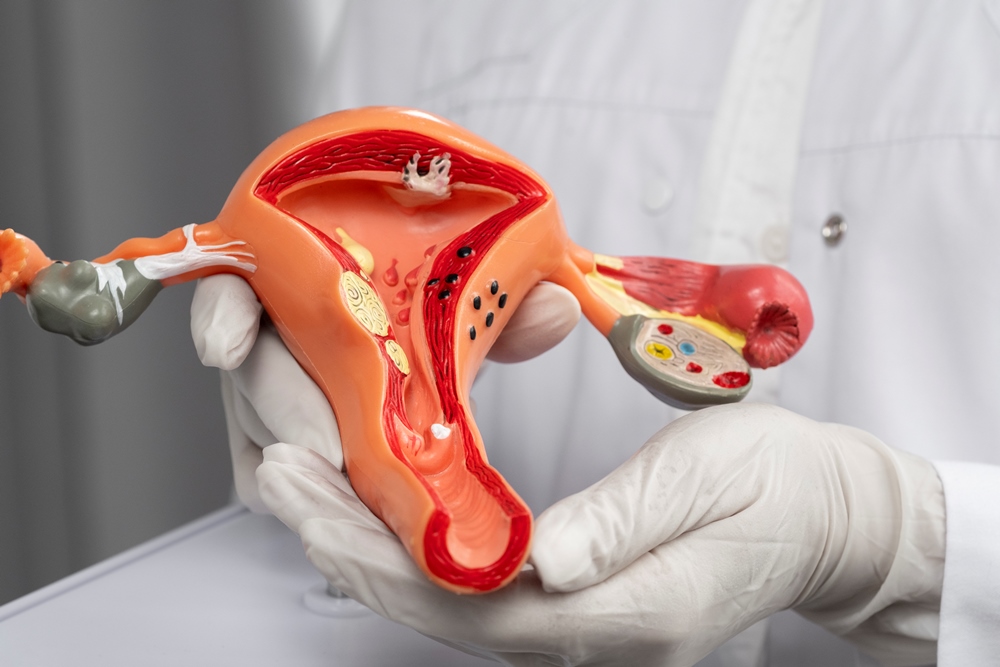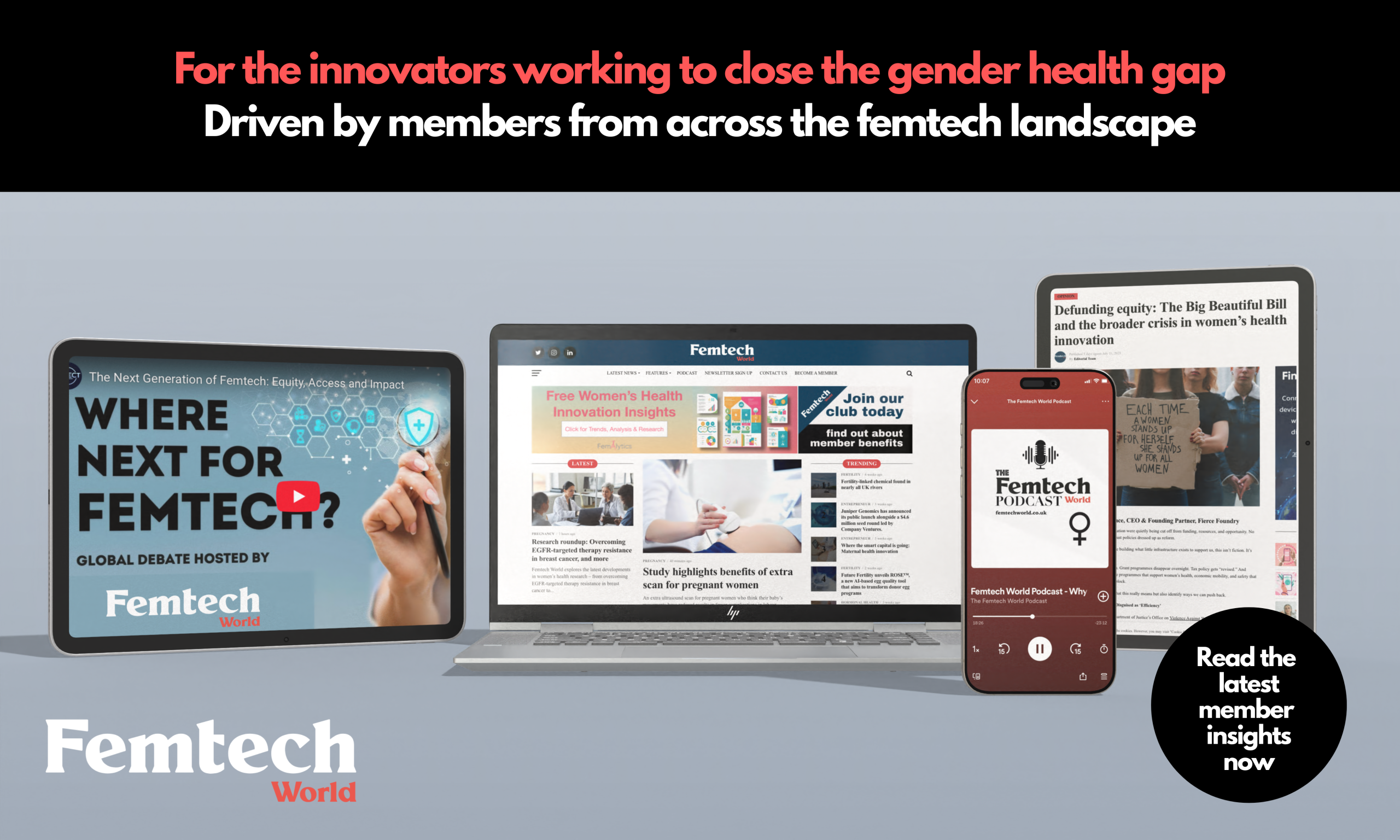Femtech World Awards
Five start-ups shortlisted for Women’s Cancer Innovation award

Five femtech start-ups have been shortlisted for the Women’s Cancer Innovation award, sponsored by FINN Partners.
FINN Partners is one of the fastest-growing, global marketing communications firms in the world. With deep expertise across sectors, FINN Partners delivers a full range of integrated marketing services relevant to key industry practice groups.
The shortlisted companies in the oncology space stood out among some truly excellent entries in one of the most competitive categories.
A category winner will be decided by the award judge and announced at a virtual ceremony on May 2.

AOA Dx is developing the next frontier in early-stage cancer detection for women through its pioneering work in glycolipids and proprietary biomarker technology. Its revolutionary tumour marker ganglioside platform, GlycoLocate, is paving the way for life-saving early cancer detection.

DeepLook Medical, a Connecticut-based software firm, focuses on visual enhancement technology to advance medical imaging. DL Precise is the first in a series of innovative products using the company’s unique shape-recognition software to delineate the details of tumour morphology – a key to better diagnosis and treatment of malignancy across the field of oncology.

10zyme aims to encourage more women to take control of their own health by improving the access to primary HPV testing, the leading cause of cervical cancer. The start-up is working on a unique self-testing option that will support the one in three who can’t attend cervical cancer screening in the UK.

OncoGenomX is a Swiss-based company on a mission to become the best treatment guidance software for breast cancer and to make durable metastasis prevention an option and a reality for all patients. Its first product, PredictionStar, represents a novel method for determining the correct cancer treatment regimen for permanent prevention of metastasis.
![]()
BIONIRS develops technologies that use light to improve society’s quality of life. The company is currently focusing on creating a medical imaging system for mammography in diffuse reflectance geometry using infrared light to improve early breast cancer diagnosis.
To receive the Femtech World newsletter, sign up here.
News
Abortion drug shows promise in reducing cancer risk

Mifepristone, widely used in medical abortions, may also lower breast cancer risk in women more likely to develop the disease.
Doctors and scientists say stigma surrounding mifepristone is deterring pharmaceutical firms from examining its use as a preventive drug, even though three studies suggest it can slow cancer cell growth.
They argue the drug’s link with abortion, along with restrictions in some countries, is blocking research that could have major public health benefits.
Mifepristone is one of two drugs, along with misoprostol, that women in the UK can use to end pregnancies up to 10 weeks.
Women take a mifepristone tablet, wait 24–48 hours and then take misoprostol. It works as a selective progesterone receptor modulator, meaning it blocks progesterone – a hormone known to drive cell growth in breast cancer.
“It is deeply disappointing that the successful application of mifepristone in one area of clinical medicine is hindering more extensive research into other indications that could benefit public health,” the eight co-authors wrote in The Lancet Obstetrics, Gynaecology and Women’s Health.
“The time is long overdue to give mifepristone the opportunity it deserves to be investigated as a non-surgical option for primary prevention.”
The authors, specialists in reproductive health and cancer, are based in London, Edinburgh, Stockholm and Erbil, Iraq.
Breast cancer kills about 670,000 women worldwide each year, according to the World Health Organization.
Mifepristone could prove particularly useful for women with BRCA1 or BRCA2 gene variants, who currently face limited choices beyond mastectomy or what the authors describe as “low efficacy” drugs.
Three small studies carried out in 2008, 2022 and 2024 showed the drug reduced progesterone’s effect on breast tissue cell growth.
UK cancer charities have joined calls for further research.
Dr Simon Vincent, chief scientific officer at Breast Cancer Now, said: “More risk-reducing treatment options for women with a high risk of developing breast cancer, that also protects their quality of life, are desperately needed. And we need to explore all avenues, including existing drugs, to achieve this.
“So early research into mifepristone is an important step forward and we need further studies to understand if these drugs are safe and effective.”
Dr Marianne Baker, Cancer Research UK’s science engagement manager, pointed to the UK’s 57,900 annual breast cancer cases as evidence that “it’s vital we invest in research exploring new ways to prevent the disease”.
She added: “Cancer develops when cells grow uncontrollably. Early studies showed that mifepristone slowed down cell growth in breast tissue, so it might be useful in delaying or preventing cancer.
“But we need more research to understand whether it’s effective, how it works and who would benefit most from it.”
Prof Kristina Gemzell Danielsson, the lead author and head of the department of women’s and children’s health at the Karolinska Institute in Stockholm, said: “Stigma around mifepristone used for abortion is describing part of why mifepristone is not more extensively researched for prevention of breast cancer.
“Taken together, our data support the use of mifepristone for prevention of poor prognosis breast cancer. All studies were randomised controlled trials using a low dose of mifepristone for two or three months.”
News
How AI is getting more women to cervical cancer screenings

Missed medical appointments cost billions, and can mean the difference between early detection and a devastating diagnosis. A pioneering AI platform is tackling medical ‘no-shows’ and getting more women into lifesaving cervical screenings.
The US loses US$150bn to missed medical appointments each year, with the cost of no-shows thought to be around £1.2bn in the UK.
Not only do these missed appointments have a huge financial burden, but they oftendelay diagnosis and treatment that could potentially save lives.
“One of the biggest problems in healthcare, especially in the US, is no-shows,” says Neil Dunwoody, co-founder and COO of medtech company, SPRYT.
“On top of that, over $1 trillion – more than a quarter of the entire US healthcare budget – is spent on administration and scheduling alone. And this isn’t just a US issue. No-shows and the costs of getting patients to their appointments are global challenges. There isn’t a single health system in the world that’s unaffected.”
In a bid to reduce the number of missed medical appointments, including oncology screenings, SPRYT has developed an agentic AI platform, designed to simplify the process of booking appointments.
ASA’s predictive model is capable of forecasting appointment no-shows with up to 92 per cent accuracy, reducing communication costs by 30 per cent.
From sport to healthcare
Initially a sports platform, linking people with others who wanted to take part in activities, SPRYT looked at algorithms that could predict whether someone would show up for activities such as a five-a-side match or a tennis game.
“We realised that, if that kind of behavioral data exists, why not apply it to healthcare? After all, there’s even more data available, and in many ways, the motivations are more explainable,” says Dunwoody.
“People might skip five-a-side because they’re anxious about who they’re playing against. But in healthcare, someone might miss an oncology appointment because they’re terrified of what they might hear. The emotional barriers are very real, and very different.”
For Dunwoody and co-founder Daragh Donohoe, the project became personal when they lost a close friend to cancer.
“He had back pain and was referred for an MRI, but couldn’t make the appointment,” says Dunwoody.
“He tried to reschedule, but the system made it so difficult that he just gave up. A year later, he was diagnosed with stage four cancer and passed away shortly after.”
Since the Covid-19 pandemic, these problems have been exacerbated, and with many GPs only offering a short time slot in the mornings to book appointments, being seen by a healthcare professional can be difficult.
“The truth is that health systems are built for administrators, not for patients. We decided to flip that,” Dunwoody adds.
Meeting patients where they are
In order to reach patients more easily, the platform uses common messaging platforms such as Whatsapp.
“We realised early on that there was no point building another app. There are already too many healthcare apps with low engagement. People just don’t use them,” Dunwoody explains.
“Instead, we looked at how people communicate. Your SMS inbox is filled with banks, utilities, spam, and scams. But your WhatsApp or Messenger threads? That’s where your friends, family, and loved ones are. People you trust. So why not manage your healthcare there?
“It’s free for patients, far cheaper for health systems than SMS, phone calls, or letters, and critically, it’s where people are most responsive. That’s why we built the system the way we did – not around apps, but around the channels people already live in.
“We were the first company in the world to integrate WhatsApp and generative AI into a live health system, specifically with the NHS’ EMIS system.”
How ASA works
At the core of the platform are two key models – a no-show prediction model, predicting with up to 92 per cent accuracy whether someone is likely to miss their appointment, and a no-show reduction model which helps to change no-show outcomes using behavioural science, linguistics, and psychology.
The no-show prediction model combines historical data pulled from electronic medical records, synthetic data to simulate millions of potential reasons someone might not show up, and live conversational data.
“The live conversational data is where it gets really powerful,” says Dunwoody.
“ASA is a fully conversational agent that can speak in 161 different languages. Through these conversations, we can detect all sorts of signals: fear, hesitation, low health literacy, whether English is someone’s first language, and so on.
“ASA analyses how people respond, whether they hesitate, how fast they reply, if they seem confused, and adapts in real time. If someone isn’t understanding the message, ASA can rephrase it, simplify it, or switch to another language to make sure they get it.
He continues: “With the no-show reduction model, the goal is to get the patient to do one of three things: book the appointment, reschedule it, or cancel ahead of time, so that slot can be filled by someone else.
“Most systems stop at prediction. They flag the risk and leave it to the health service to act. What makes ASA different is that it engages directly with the patient, in a natural, empathetic conversation.”
SPRYT has also developed a Retrieval-Augmented Generation (RAG) model which ensures the AI is always referencing pre-approved, accurate information such as FAQs from clinic websites, official guidelines from organisations, and operational information like clinic locations, parking, or childcare availability.
Additionally, Dunwood explains, in areas where literacy or language barriers are common or where people are visually impaired, SPRYT has developed a feature called “voice note tennis.”
ASA sends a voice message in the patient’s preferred language, and they reply the same way.
“It’s more natural, more human, and genuinely accessible,” he adds.
Boosting cervical screenings in the NHS
Following a successful pilot focused on improving take-up of the HPV vaccine, ASA is currently operating within the NHS in north central London, managing cervical cancer screening appointments, and has already seen promising results.
“Booking rates for cervical screenings jumped from 10 per cent to 160 per cent,” says Dunwoody.
“Administrative workloads dropped by over eight hours per week per clinical administrator. We’ve achieved a 33 per cent reduction in SMS costs and over 60 per cent when you factor in saved costs from letters and phone calls. Now, 25 per cent of patients book outside normal office hours, often at night or early morning. That’s the beauty of ASA, it doesn’t sleep.”
Alongside this, SPRYT is also working on other initiatives to support the NHS’s objective of eliminating cervical cancer by 2040, such as providing women with at-home screening tests.
“We contact a patient twice for smear tests and, if they don’t respond or book, we’ll send them an at-home cancer screening test,” says Dunwoody.
“There is a big push in the redirection of NHS England, to keep patients out of hospitals or clinics, and the best way to do that is at home testing for things like this.”
Meanwhile, in the US, the SPRYT ASA platform is now part of the Mayo Clinic innovation exchange, and the company is looking at rolling out a programme at Cleveland Clinic, as well as looking to expand into other areas of healthcare including diabetes and lung screening.
SPRYT’s ASA platform won Femtech World’s Cancer Innovation of the Year Award 2025.
Hormonal health
Interview: New horizons in endometriosis diagnosis

Winner of the Femtech World Menstrual Health Innovation Award 2025, Serac Healthcare, is aiming to revolutionise endometriosis diagnosis via a non-invasive diagnostic molecular imaging agent. Serac Healthcare chief executive, David Hail, speaks to FemTech World about the company’s mission to improve diagnostic timelines for the condition and empower women’s health.
Endometriosis affects more than 176 million women across the globe, causing chronic pelvic pain, painful menstrual cycles, painful intercourse, bloating and fertility issues.
Unfortunately, women are often waiting up to eight years to be diagnosed, often experiencing dismissal over their symptoms.
While scans such as MRI can provide insights into whether or not a person has endometriosis, currently, official diagnosis of the condition is done through an invasive surgical procedure called a laparoscopy, where a camera is inserted into the abdomen.
With no innovation in endometriosis diagnosis or treatment, Serac Healthcare is working to redefine how we diagnose the condition through its innovative non-invasive method.
Serac Healthcare chairman, David Hail, tells Femtech World that Serac’s imaging agent has the potential to revolutionise diagnosis and empower the development of new drugs for the condition.
“We have a real excitement and a real passion about bringing precision medicine – nuclear medicine – to people,” says Hail.
“Nuclear medicine is a way of looking at physiological processes in the body, and is very often used to see active disease in the bodies of patients, which is different to other imaging techniques.”
Serac’s imaging agent – Tc-maraciclatide – which has been granted Fast Track Designation by the FDA, is a radio-labeled tracer that has been designed to bind to new blood vessel formation.
“That’s really important in a lot of inflammatory conditions,” explains Hail.
For instance, with endometriosis, where cells from the endometrium grow outside the uterus, to be able to survive in that environment, they have to grow their own blood supply.
“That’s what we image. So, maraciclatide binds to this new blood vessel formation, which is called angiogenesis, and we can scan somebody, pinpoint that and see it.
“That is also why it works in inflammatory arthritis – rheumatoid arthritis and psoriatic arthritis, which, incidentally, is also a disease predominantly of women. In fact, autoimmune diseases generally are more prevalent in women than men, but for rheumatoid arthritis, 70 per cent of patients with rheumatoid arthritis are women.”
Hail highlights that one in two women who go for fertility treatment have endometriosis, and that these women often discover they have endometriosis when they start fertility treatment.
“At the moment, the only definitive diagnostic test for endometriosis is surgery. We know there’s a several month recovery period from laparoscopic surgery.
“In laparoscopic surgery, the surgeon can see the endometrial tissue and it is also a treatment – they can also take out the tissue, so having a definitive imaging agent that can visualize and diagnose the early stage of endometriosis is incredibly important.
“It can change the whole care pathway for some women today. When there are eight years between a woman seeing a clinician and having a formal diagnosis – apart from the physiological damage – there is psychological damage, because quite often, women are told it’s just in their heads.”
Serac has carried out clinical studies on the imaging agent, with findings from the Phase II study, carried out by a team from Oxford University, demonstrating that it can visualise and diagnose the very earliest stage of endometriosis.
“The very earliest stage of endometriosis is superficial peritoneal endometriosis (SPE) in which there are very small lesions,” explains Hail.
“Visualising this stage is really important because it is the start of the active disease, and therefore, there is the potential to intervene sooner.”
“Apart from the physiological damage and the psychological damage – there is real economic harm to the women involved. This happens at exactly the time when they are arguably at their most productive – in the early stages of their career and relationships. All these things that are negatively impacted by endometriosis.
“Our mission is about being able to bring something to the world that can make an impact on that.”
Beyond early diagnosis of the condition, Hail says that the agent may also contribute to research and the development of new drugs to treat the condition.
“This is also really important for developing new disease modifying drugs – drugs that actually get to the underlying disease, as opposed to masking them,” says Hail.
“We know that the treatments available today are not perfect – such as hormones, an example of which would be the contraceptive pill which mimics pregnancy. We know there are potential side effects from these hormonal therapies, as indeed there are from the ‘pill’.
“There are people trying to develop new disease modifying drugs, but to prove a drug works in endometriosis, you have to choose pain as an endpoint.
“There’s lots of variables that can affect pain and there isn’t a direct understanding of the relationship between the endometriosis itself and pain. The only alternative to prove that your new drug actually works and actually reduces the burden of endometrial lesions is surgery – in fact, two blocks of surgery.
“It is very difficult to run clinical trials around that for all sorts of reasons. So potentially, having this imaging agent is an alternative way to prove that your drug is actually doing what you hope it will do.”
The outline for a Phase III study has now been agreed, and Hail says that the agent being granted fast track designation in the US highlights the FDA’s recognition of the need for innovation in endometriosis care.
“Women’s Health generally, but endometriosis in particular, is an underserved area,” says Hail.
“We think it is so important to bring something to the world that’s going to make a real difference to 50 per cent of the population of the planet – we really need to do something about it, and that’s what we’re trying to do.
“Early diagnosis of endometriosis is important because it allows physicians to provide timely, effective treatment, and the best treatments that are available.”
The Femtech World Menstrual Health Innovation Award 2025 is sponsored by Clue. See all our winners here.

 News2 weeks ago
News2 weeks agoFDA plans to revise black box warning on menopause hormone therapies

 News2 weeks ago
News2 weeks agoAI-powered women’s health companion Nexus launches in UK

 News2 weeks ago
News2 weeks agoScientists turn human skin cells into eggs in IVF breakthrough

 News6 days ago
News6 days agoWomen’s health innovations recognised in TIME’s Best Inventions 2025

 Hormonal health2 weeks ago
Hormonal health2 weeks agoDaily pill could delay menopause ‘by years,’ study finds

 News2 weeks ago
News2 weeks agoAncient herb to modern must-have: Why ashwagandha is capturing UK women’s attention

 Menopause3 weeks ago
Menopause3 weeks agoNew report exposes perimenopause as biggest blind spot in women’s health

 News1 week ago
News1 week agoMenstrual cycle affects women’s reaction time, study finds































1 Comment